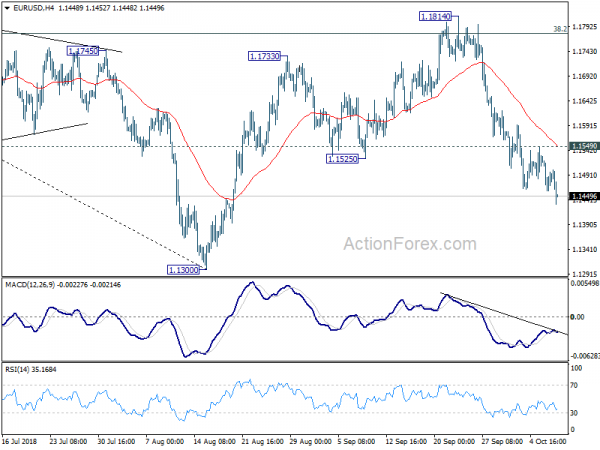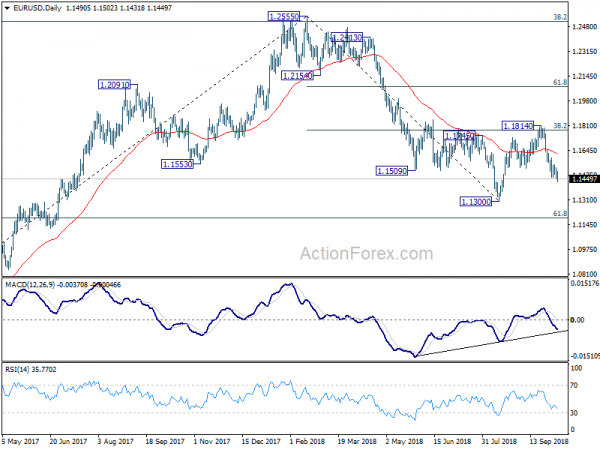Euro suffers heavy selling today as German-Italian yield spread widens further to above 310. It’s clear that Italy is not doing to back down on its budget deficit plan despite strong criticism from EU. Besides, it would be facing risks of downgrade by credit agencies. Additional Euro weighed down by weak German trade data and IMF’s growth forecasts downgrade. At the time of writing, Euro is the weakest one for today for sure. The second weakest is taken by Kiwi, then Sterling. Yen and Dollar are the strongest ones, followed by Australian Dollar.
Risk aversion dominates European markets. DAX leads the way down by losing -0.59%, CAC down -0.42%, FTSE down -0.50%. Italian 10 year yield is currently up 0.062 at 3.629. German 10 year yield up 0.017 at 0.551. Earlier today, Italian 10 year yield hit as high as 3.712. In Asia, Nikkei closed down -1.32%, Singapore Strait Times down -0.47%. Hong Kong HSI just lost -0.11%. China Shanghai SSE indeed closed up 0.17%.
Technically, EUR/USD picks up downside momentum again and fall from 1.1814 is on track to retest 1.1300 low. EUR/CHF will be looking at 1.1361 minor support to confirm completion of recent corrective rebound. USD/CHF is pressing 0.9954 temporary top and could resume rally or extend consolidation, depending on the fate of EUR/CHF. USD/JPY draws some support from 112.94. fibonacci level and focus will be back on 113.55 minor resistance to confirm completion of pull back from 114.54.
Italy EM Tria defends “prudent” budget plan
Italian Economy Minister Giovanni Tria defended the country’s budget plan in a parliamentary commission today. He emphasized the the targets in the plan are “prudent”. Also, with the plan, Italy will “significantly reduce, within the first two years of this legislature, the growth gap with the Eurozone and bring about the first significant decrease in the debt ratio over the next three years.”
Tria expected the plan to cut taxes and raise welfare spending to boost growth to 1.5% in 2019, 1.6% in 2020 and 1.4% in 2021. And with growth back to pre-crisis levels, Italy’s structural deficit full because of that. Under the plan, the overall budget deficit will be 2.4% in 2019, 2.1% in 2020 and 1.8% in 2021.
Tria also told lawmakers that “a constructive dialogue with the EU Commission will start, and will look at the reasonable contents of what is contained in the budget”.
German imports and exports contracted in August, more evidence of slowdown
In seasonally adjusted term, German trade balance widened to EUR 18.3B in August. Export dropped -0.1% yoy while import dropped even more by -2.7% yoy. The data added further evidence that the German economy is losing momentum again. It also echoed industrial production data released yesterday, which unexpectedly contracted -0.3% yoy in August.
In the updated forecasts by IMF, German GDP is expected to grow 1.9% in 2018, a large downward revision from April forecast of 2.5%> For 2019, growth projection was also revised to 1.9%, down from 2.0%.
The German government is due to release its updated economy forecasts this Thursday. And it’s expected that there would be downward revision to growth for this year and next too.
Australian Business confidence rose, ongoing strength but meek price pressures
Australian NAB Business Confidence rose to 6 in September, up from 5 and beat expectation of 5. Business Conditions rose to 15, up from 14 and beat expectation of 9.
Alan Oster, NAB Group Chief Economist noted in the release that “Business conditions appear to have stabilized after declining through the middle of 2018.” Also, “despite having eased notably from the highs earlier in the year, they remain well above average, suggesting that the Business environment continues to be favorable”. And, “ongoing strength in employment is especially encouraging.”
The only concern remains around “lower forward orders”. Mining again is strongest but “retail is weak and deteriorating”. And, “retail has now lagged for some time and is unlikely to turn around anytime soon with the weaker outlook for the consumer and ongoing structural changes in the sector”. Overall, the survey points to “ongoing strength in Business activity” in to latter part of 2018, but “ongoing meek price pressures”.
IMF downgrades global growth forecasts as risks materialized
IMF downgraded global growth forecasts for both 2018 and 2019 as some downside risks identified earlier in April have been realized and “the likelihood of further negative shocks to our growth forecast has risen.” The risks included “rising trade barriers and a reversal of capital flows to emerging market economies”. Financial market conditions could “tighten rapidly” if trade tensions and policy uncertainty were to intensify. And, unexpectedly high inflation readings in the US could “lead investors to abruptly reassess risks”
In several key economies, “growth is being supported by policies that seem unsustainable over the long term.” IMF warned that “these concerns raise the urgency for policymakers to act.” For the US, IMF said “growth will decline once parts of its fiscal stimulus go into reverse.” Also, US forecasts were downgraded “owing to the recently enacted tariffs on a wide range of imports from China and China’s retaliation”, At the same time, China’s 2019 forecasts was also marked down. IMF also warned that “domestic Chinese policies are likely to prevent an even larger growth decline than the one we project, but at the cost of prolonging internal financial imbalances.”
- Global growth projected at 3.7% (3.9% prior) in 2018, 3.7% (3.9% prior) in 2019.
- US growth projected at 2.9% (2.9% prior) in 2018, 2.5% (2.7% prior) in 2019.
- Eurozone growth projected at 2.0% (2.4% prior) in 2018, 1.9% (2.0% prior) in 2019.
- Germany growth projected at 1.9% (2.5% prior) in 2018, 1.9% (2.0% prior) in 2019.
- Japan growth projected at 1.1% (1.2% prior) in 2018, 0.9% (2.9% prior) in 2019.
- UK growth projected at 1.4% (1.6% prior) in 2018, 1.4% (1.5% prior) in 2019.
- China growth projected at 6.6% (6.6% prior) in 2018, 6.2% (6.4% prior) in 2019.
EUR/USD Mid-Day Outlook
Daily Pivots: (S1) 1.1459; (P) 1.1494; (R1) 1.1529; More…..
EUR/USD’s fall from 1.1814 continues today and reaches as low as 1.1431 so far. Intraday bias remains on the downside for retesting 1.1300 low. Decisive break there will resume larger down trend from 1.2555. On the upside, break of 1.1549 resistance is needed to signal short term bottoming. Otherwise, outlook will remain mildly bearish even in case of recovery..
In the bigger picture, corrective pattern from 1.1300 could have completed at 1.1814 after hitting 38.2% retracement of 1.2555 to 1.1300at 1.1779. Decisive break of 1.1300 will resume the down trend from 1.2555 to 61.8% retracement of 1.0339 (2017 low) to 1.2555 at 1.1186 next. Sustained break there will pave the way to retest 1.0339. On the upside, break of 1.1814 will delay the bearish case and extend the correction from 1.1300 with another rise before completion.
Economic Indicators Update
| GMT | Ccy | Events | Actual | Forecast | Previous | Revised |
|---|---|---|---|---|---|---|
| 23:01 | GBP | BRC Retail Sales Monitor Y/Y Sep | -0.20% | 0.10% | 0.20% | |
| 23:50 | JPY | Current Account (JPY) Aug | 1.43T | 1.52T | 1.48T | |
| 00:30 | AUD | NAB Business Conditions Sep | 15 | 9 | 15 | 14 |
| 00:30 | AUD | NAB Business Confidence Sep | 6 | 5 | 4 | 5 |
| 05:00 | JPY | Eco Watchers Survey Current Sep | 48.6 | 47.3 | 48.7 | |
| 06:00 | EUR | German Trade Balance (EUR) Aug | 18.3B | 15.9B | 15.8B | |
| 10:00 | USD | NFIB Small Business Optimism Sep | 107.9 | 108.9 | 108.8 | |
| 12:15 | CAD | Housing Starts Sep | 189K | 203K | 201K |













